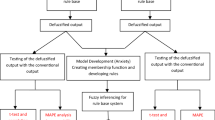Abstract
The aim of this study is to propose an new approach, fuzzy item response model (FIRM), which combines item response theory (IRT) and fuzzy set theory, in the educational or psychological measurement. Applying FIRM to improve the predictive validity of psychological measurement is verified. We set up a detailed procedure for the FIRM and apply it to a valuable empirical study with Beck Depression Inventory-II (Chinese version) administrated on outpatient diagnosed as depression was given. The results showed the correct classification of depression based on FIRM scoring was 80.3% while that of raw score was only 73.2%. That is, via FIRM scoring, 7.9% of the erroneous judgments of depression inferred from self-reported inventory were reduced. It is also suggested that considerable cost concerning prevention and cure of depression might be reduced via FIRM.
Similar content being viewed by others
References
Agresti A. (1996). An introduction to categorical data analysis. John Wiley and Sons, New York
American Psychiatric Association.: Diagnostic and statistical manual of mental disorders. American Psychiatric Association, Washington DC (1994)
Beck A.T., Steer R.A. and Brown G.K. (1996). Manual for the beck depression inventory–II. Psychological Corporation, San Antonio, TX
Bilgic T. and Turksen B. (2000). Measurement of membership function: theoretical and empirical work. In: Dubios, D. and Prade, H. (eds) Fundamentals of fuzzy sets, pp 195–232. Kluwer, Boston
Cheng S.J. and Hwang C.L (1992). Fuzzy multiple attribute decision making: methods and applications. Springer-Verlag, Berlin
Dubios D., Ostasiewicz W. and Prade H. (2000). Fuzzy sets: history and basic notions. In: Dubios, D. and Prade, H. (eds) Fundamentals of fuzzy sets, pp 21–124. Kluwer, Boston
Goleman, D. Costs of depression are on a par with heart disease, a study says. The New York Times, December 3, 1993
Guilford J.P. (1954). Psychometric methods. McGraw-Hall, New York
Hopkins K.D., Stanley J.C. and Hopkins B.R. (1990). Education and psychological measurement and evaluation. Prentice Hall, Englewood Cliffs, NJ
Krefetz D.G., Steer R.A., Gulab N.A. and Beck A.T. (2002). Convergent validity of the Beck Depression Inventory–II with the Reynolds adolescent depression scale in psychiatric inpatients. J. Person. Assess. 78(3): 451–460
Klir G. and Yuan B. (1995). Fuzzy sets and fuzzy logic: theory and applications. Prentice Hall, Englewood Cliffs, NJ
Kosko B. (1993). Fuzzy thinking: the new science of fuzzy logic. Hyperion, New York
Law C.K. (1996). Using fuzzy numbers in educational grading system. Fuzzy Sets Syst. 83: 311–323
Lin Y.H. (2001). The simulation study of reliability of fuzzy linguistic scales. J. Test Stat. 9: 193–219
Lin Y.H. (2003). The comparison of different algorithms and scoring. J Taichuang Teacher Coll. 17(2): 279–304
Lin, Y.H.: The data simulation and empirical study of fuzzy linguistic scoring. (NSC92-2413-H-142-004) (2004)
Linacre J.M. (2005). A User’s guide to WINSTEPS Rasch-model computer programs. Winsteps, Chicago
Masters G.N. (1982). A Rasch model for partial credit scoring. Psychometrika 47: 149–174
Masters G.N. and Wright B.D. (1984). The essential process in a family of measurement models. Psychometrika 49: 529–544
Masters G.N. and Wright B.D. (1997). The partial credit model. In: van der Linden, W.J. and Hambleton, R.K. (eds) Handbook of modern item response theory, pp 101–122. Springer-Verlag, New York
Medasani S., Kim J. and Krishnapuram R. (1998). An overview of membership function generation techniques for pattern recognition. Int J Approx Reason 19: 391–471
Nguyen H. and Wu B.L. (2000). Fuzzy mathematics and statistical analysis. Junjie, Taipei
Nunnally J.C. and Berstein I.H. (1994). Psychometric theory. McGraw-Hall, New York
Rasch, G.: Probabilistic models for some intelligence and attainment tests. [Danish Institute of Educational Research 1960, University of Chicago Press 1980, MESA Press 1993] MESA Press, Chicago (1960)
Thurstone L.L. (1931). Measurement of social attitudes. J. Abnormal Soc. Psychol. 26: 249–269
Wright B.D. (1994). Rasch factor analysis. Rasch Measure Trans 8(1): 348–349
Wright B.D. (1999). Fundamental measurement for psychology. In: Embretson, S.E. and Hershberger, S.L. (eds) The new rules of measurement: what every educator and psychologist should know, pp 235–255. Lawrence Erlbaum, Hillsdale, NJ
Wright B.D. and Linacre J.M. (1989). Observations are always ordinal: measures, however, must be interval. Arch. Phys. Med. Rehabilitation 70: 857–860
Wright B.D. and Masters G.N. (1982). Rating scale analysis: Rasch measurement. MESA Press, Chicago
Wu B.L. (1995). Fuzzy statistics analyzing: a new approach to survey research. Newsletter Nat. Chengchi Univ. 2: 65–80
Wu B.L. and Hsu Y.Y. (2004). The use of kernel set and sample memberships in the identification of nonlinear time series. Soft Comput 8: 207–216
Wu, B.L., Lin, Y.H.: Fuzzy mode and its applications in educational and psychological assessment analysis. Paper Presented on the Second International Conference on Information. China, Beijing (2002a)
Wu B.L. and Lin Y.H. (2002b). The introduction of fuzzy mode and its applications. J. Test Stat. 47: 23–27
Yu, S.: Fuzzy partial credit scaling: applying fuzzy set theory to scoring rating scales. Unpublished doctoral dissertation, National Chengchi University, Taipei, Taiwan (2005)
Zadeh L.A. (1965). Fuzzy sets. Inform Control 8: 338–352
Zimmermann H.J. (1996). Fuzzy set theory and its applications. Kluwer, Boston
Author information
Authors and Affiliations
Corresponding author
Rights and permissions
About this article
Cite this article
Yu, SC., Wu, B. Fuzzy item response model: a new approach to generate membership function to score psychological measurement. Qual Quant 43, 381–390 (2009). https://doi.org/10.1007/s11135-007-9114-2
Received:
Accepted:
Published:
Issue Date:
DOI: https://doi.org/10.1007/s11135-007-9114-2




